The Influence of Spatial Grid Division on the Layout Analysis of Urban Functional Areas
Abstract
:1. Introduction
2. Related Research
3. Research Area and Data
3.1. Study Area
3.2. Data Collection and Processing
4. Methods
4.1. Kernel Density Analysis
4.2. Grid Size Determination
4.3. Quantitative Identification of Functional Areas
5. Results and Discussion
5.1. Kernel Density Analysis of POI Data
5.2. Grid Size
5.3. Identification of Functional Areas
5.3.1. Single-Functional Area
5.3.2. Mixed-Functional Area
6. Conclusions
Author Contributions
Funding
Data Availability Statement
Acknowledgments
Conflicts of Interest
References
- Hu, Y.F.; Han, Y.Q. Identification of Urban Functional Areas Based onPOI Data: A Case Study of the Guangzhou Economicand Technological Development Zone. Sustainability 2019, 11, 1385. [Google Scholar] [CrossRef] [Green Version]
- Ding, Y.W.; Xu, H.W.; Wang, C.H. Research on Urban Functional Area Recognition Integrating OSM Road Network and POI Data. J. Geo-Inf. Sci. 2020, 36, 57–63. [Google Scholar] [CrossRef]
- Li, M. Shanghai Grid in Action: The First Stage Projects towards Digital City and City Grid. Grid and Cooperative Computing; Li, M., Sun, X.H., Deng, Q., Eds.; Springer: Berlin/Heidelberg, Germany, 2004; Volume 3032, pp. 616–623. [Google Scholar]
- Wang, Z.; Han, D.Q. GRID-A METHOD OF DESIGN TO THE URBAN SPATIAL FORM. City Plan. Rev. 2003, 3, 67–72. [Google Scholar]
- Peng, C. Evaluating Grid City from City Space Forms Performance Guidelines. South Archit. 2006, 12, 5–8. [Google Scholar]
- Du, M.Y.; Liu, Y. The application of internet of things in urban fine management. Sci. Surv. Map. 2017, 42, 94–102. [Google Scholar] [CrossRef]
- Dang, W.J. Study on the Rational Structure of Urban Road System. Master’s Thesis, Chang’an University, Xi’an, China, 2009. [Google Scholar]
- Li, W.D.; Zhang, M.L.; Duan, J.L. The research of Nanjing urban spatial pattern based on POI data. World Reg. Stud. 2020, 29, 317–326. [Google Scholar] [CrossRef]
- Xu, Z.N.; Gao, X.L. A novel method for identifying the boundary of urban built-up areas with POI data. Acta Geogr. Sin. 2016, 71, 928–939. [Google Scholar] [CrossRef]
- Chen, D.Q.; Lan, Z.Y. Study on Identification of Urban Center System and Boundary Extraction Based on POI Data: A Case Study of Six Center Districts of Changsha. Mod. Urban Res. 2020. [Google Scholar] [CrossRef]
- Sun, B.; Shi, W.; Ning, Y. An Empirical Study on the Polycentric Urban Structure of Shanghai and Strategies in Future. Urban Plan. 2010, 23, 58–63. [Google Scholar] [CrossRef]
- Wang, Y.D.; Gu, Y.Y.; Dou, M.X.; Qiao, M.L. Using Spatial Semantics and Interactions to Identify Urban Functional Regions. Int. J. Geogr. Inf. Sci. 2018, 7, 130. [Google Scholar] [CrossRef] [Green Version]
- Chen, Z.; Arisona, M.; Huang, X.; Batty, M.; Schmitt, G. Detecting the dynamics of urban structure through spatial network analysis. Int. J. Geogr. Inf. Sci. 2014, 28, 2178–2199. [Google Scholar] [CrossRef]
- Chen, Z.; Arisona, M.; Huang, X.; Schmitt, G. Identifying spatial structure of urban functional centers using travel survey data: A case study of Singapore. In Proceedings of the First ACM SIGSPATIAL International Workshop on Computational Models of Place, Orlando, FL, USA, 5–8 November 2013; pp. 28–33. [Google Scholar] [CrossRef]
- Zhao, Z.Y. Spatial Pattern of China’s Population Migration Based on Big Data and Its Impact on Urbanization. Ph.D. Thesis, Jilin University, Jilin, China, 2018. [Google Scholar]
- Zhou, W.; Li, Q.; Li, Z.; Wang, N.; Wang, Q. Dynamic interactions between spatial change and travel behavior variation in old town fringe. J. Transp. Land Use 2020, 13, 559–584. [Google Scholar] [CrossRef]
- Zhou, W. SIO-CNN Based Urban Functional Zone Fine Division with VHR Remote Sensing Image. Master’s Thesis, China University of Geosciences, Wuhan, China, 2019. [Google Scholar]
- Liu, H.M.; Xu, Y.Y.; Tang, J.B.; Deng, M.; Hang, J.C.; Yang, W.T.; Wu, F. Recognizing urban functional zones by a hierarchical fusion method considering landscape features and human activities. Trans. GIS 2020, 24. [Google Scholar] [CrossRef]
- Song, J.C.; Tong, X.Y.; Wang, L.Z.; Zhao, C.; Prishchepov, A.L. Monitoring finer-scale population density in urban functional zones: A remote sensing data fusion approach. Landsc. Urban Plan. 2019, 190. [Google Scholar] [CrossRef]
- Han, Y.; Li, H. The Spatial-temporal Characteristics of Urban Economic Inequality in Northeast China Based on DMSP/OLS Night-time Light Data. Northeast Asia Econ. Res. 2020, 4, 66–77. [Google Scholar] [CrossRef]
- Zheng, Z.H.; Wu, Z.; Chen, Y.; Yang, Z.; Francesco, M. Analyzing the ecological environment and urbanization characteristics of the Yangtze River Delta Urban Agglomeration based on Google Earth Engine. Acta Ecol. Sin. 2021, 41. [Google Scholar] [CrossRef]
- Deng, Y.; Liu, J.; Liu, Y.; Luo, A. Detecting Urban Polycentric Structure from POI Data. ISPRS Int. J. Geo-Inf. 2019, 8, 283. [Google Scholar] [CrossRef] [Green Version]
- Yi, D.; Yang, J.; Liu, J.; Liu, Y.; Zhang, J. Quantitative Identification of Urban Functions with Fishers’ Exact Test and POI Data Applied in Classifying Urban Districts: A Case Study within the Sixth Ring Road in Beijing. ISPRS Int. J. Geo-Inf. 2019, 8, 555. [Google Scholar] [CrossRef] [Green Version]
- Zhang, X.; Du, S.; Wang, Q. Hierarchical community detection and functional area identification with OSM roads and complex graph theory. Int. J. Geogr. Inf. Sci. 2019, 33. [Google Scholar] [CrossRef]
- Lu, C.; Pang, M.; Zhang, Y.; Li, H.; Lu, C.; Tang, X.; Cheng, W. Mapping Urban Spatial Structure Based on POI (Point of Interest) Data: A Case Study of the Central City of Lanzhou, China. ISPRS Int. J. Geo-Inf. 2020, 9, 92. [Google Scholar] [CrossRef] [Green Version]
- Xing, H.; Meng, Y. Integrating landscape metrics and socioeconomic features for urban functional region classification. Comput. Environ. Urban Syst. 2018, 72, 134–145. [Google Scholar] [CrossRef]
- Liu, J.; Deng, Y.; Wang, Y.; Huang, H.; Du, H.; Ren, F. Urban Nighttime Leisure Space Mapping with Nighttime Light Images and POI Data. Remote Sens. 2020, 12, 541. [Google Scholar] [CrossRef] [Green Version]
- Chen, Y.; Chen, X.; Liu, Z.; Li, X. Understanding the spatial organization of urban functions based on co-location patterns mining: A comparative analysis for 25 Chinese cities. Cities 2020, 97. [Google Scholar] [CrossRef]
- Andrade, R.; Alves, A.; Bento, C. POI Mining for Land Use Classification: A Case Study. ISPRS Int. J. Geo-Inf. 2020, 9, 493. [Google Scholar] [CrossRef]
- Yan, M.M.; Jiang, C. Comprehensive Environmental Management of Historic and Cultural Blocks in Old City—A Case Study of Shichahai Area in Xicheng District, Beijing. In Proceedings of the 2010 International Conference on Management and Service Science, Wuhan, China, 24–26 August 2010; pp. 1–4. [Google Scholar] [CrossRef]
- Xue, F.; Zhang, J.; Cui, Y.; He, L.; Zhong, Y. Urban Small Green Space Layer Structure Mapping and Quantitative Research—A Case of Beijing Xihai Waterfront and Qingfeng Park East Area. Chin. Landsc. Archit. 2020, 36, 133–138. [Google Scholar] [CrossRef]
- Zhang, L. Research on POI Classification Standard. Bull. Surv. Mapp. 2012, 82–84. [Google Scholar]
- Sun, X. Spatialization and Autocorrelation Analysis of Urban Population Kernel Density Supported by Nighttime Light Remote Sensing. J. Geo-Inf. Sci. 2020, 22, 2256–2266. [Google Scholar] [CrossRef]
- Zhou, Y.; Li, X.; Tong, Y.; Huang, H. The geographical pattern and differentiational mechanism of rural poverty in China. Acta Geogr. Sin. 2020, 1–19, (accepted). [Google Scholar]
- Swift, A.; Liu, L.; Uber, J. Reducing MAUP bias of correlation statistics between water quality and GI illness. Comput. Environ. Urban Syst. 2008, 32, 134–148. [Google Scholar] [CrossRef]
- Rao, J.W.; Ma, R.H. Improved Kernel Density Estimator Based Spatial Point Density Algorithm. Comput. Eng. Appl. 2020, 1–8. [Google Scholar] [CrossRef]
- Xing, R.; Ai, T.; Yang, W.; Feng, T.A. New Network Voronoi Diagram Considering the OD Point Density of Taxi and Visual Analysis of OD Flow. J. Geo-Inf. Sci. 2015, 17, 1187–1195. [Google Scholar] [CrossRef]
- Yu, W.H.; Ai, T.H.; Yang, W.; Feng, T. The Visualization and Analysis of POI Features under Network Space Supported by Kernel Density Estimation. Acta Geod. Cartogr. Sin. 2015, 44, 82–90. [Google Scholar] [CrossRef]
- Li, S.Q.; Sheng, C.Y.; Wang, J.C. Algorithm of Cartographical Generalization for Point Cluster Features Based on Point Density Analysis and Adaptive Difference Detection. J. Geo-Inf. Sci. 2019, 35, 1–5+151. [Google Scholar] [CrossRef]
- Wu, W.; Deng, G.Q.; Wu, X.L. Geographic Grids and Their Application in Statistical Analysis. Stand. Surv. Mapp. 2015, 31, 22–26. [Google Scholar]
- Fu, H.Y.; Li, M.C.; Zhao, J.; Liu, Y.X. SUMMARY OF GRID TRANSFORMATION MODELS OF POPULATION DATA. Hum. Geogr. 2006, 115–119+114. [Google Scholar] [CrossRef]
- Zhao, J. Study on the Changes of National Population and Economy Based on the Grid under the Shared Socioeconomic Pathways by IPCC. Master’s Thesis, Nanjing University of Information Science and Technology, Nanjing, China, 2018. [Google Scholar]
- Lian, W.J. Reaearch on Geographic Object Model and Key Technologies Based on Discrete Global Grid System. Master’s Thesis, Nanjing Normal University, Nanjing, China, 2019. [Google Scholar]
- Silverman, B.W. Density Estimation for Statistics and Data Analysis; Chapman and Hall: London, UK, 1986; pp. 34–48. [Google Scholar]
- Lin, X. Research on Evolution Characteristics and Optimization of Shopping Center Spatial Layout in Central Chongqing. Master’s Thesis, Southwest University, Chongqing, China, 2020. [Google Scholar] [CrossRef]
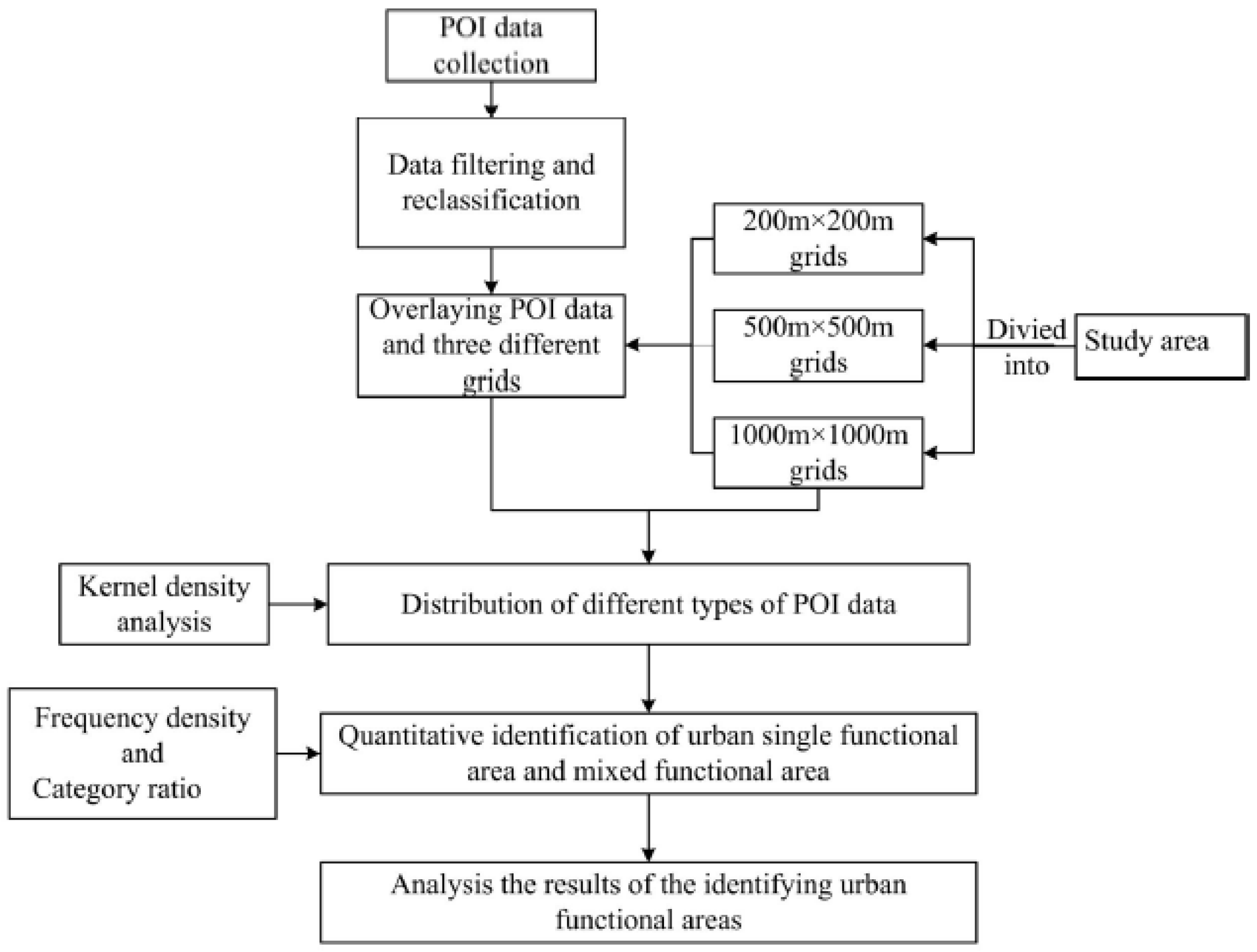
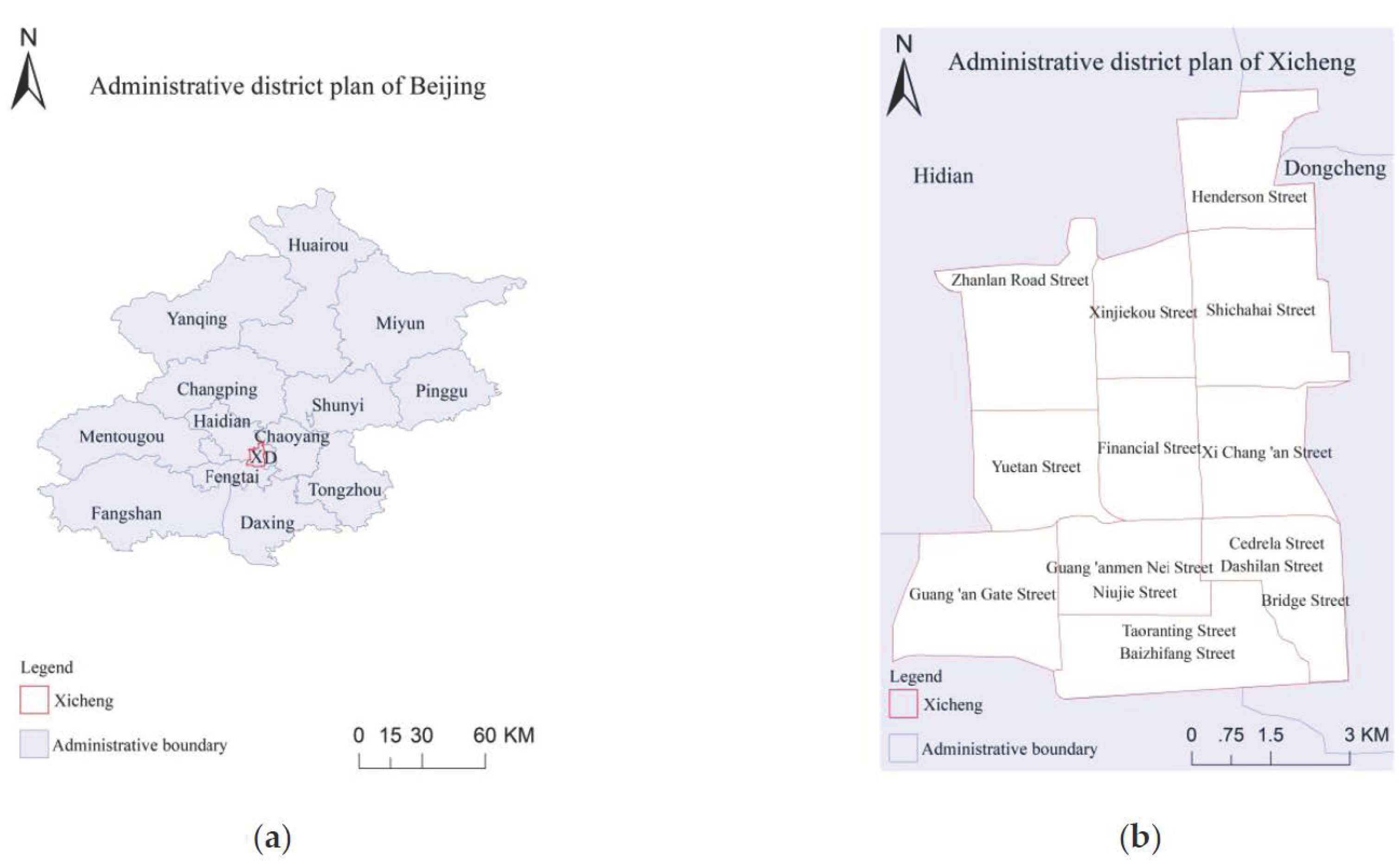


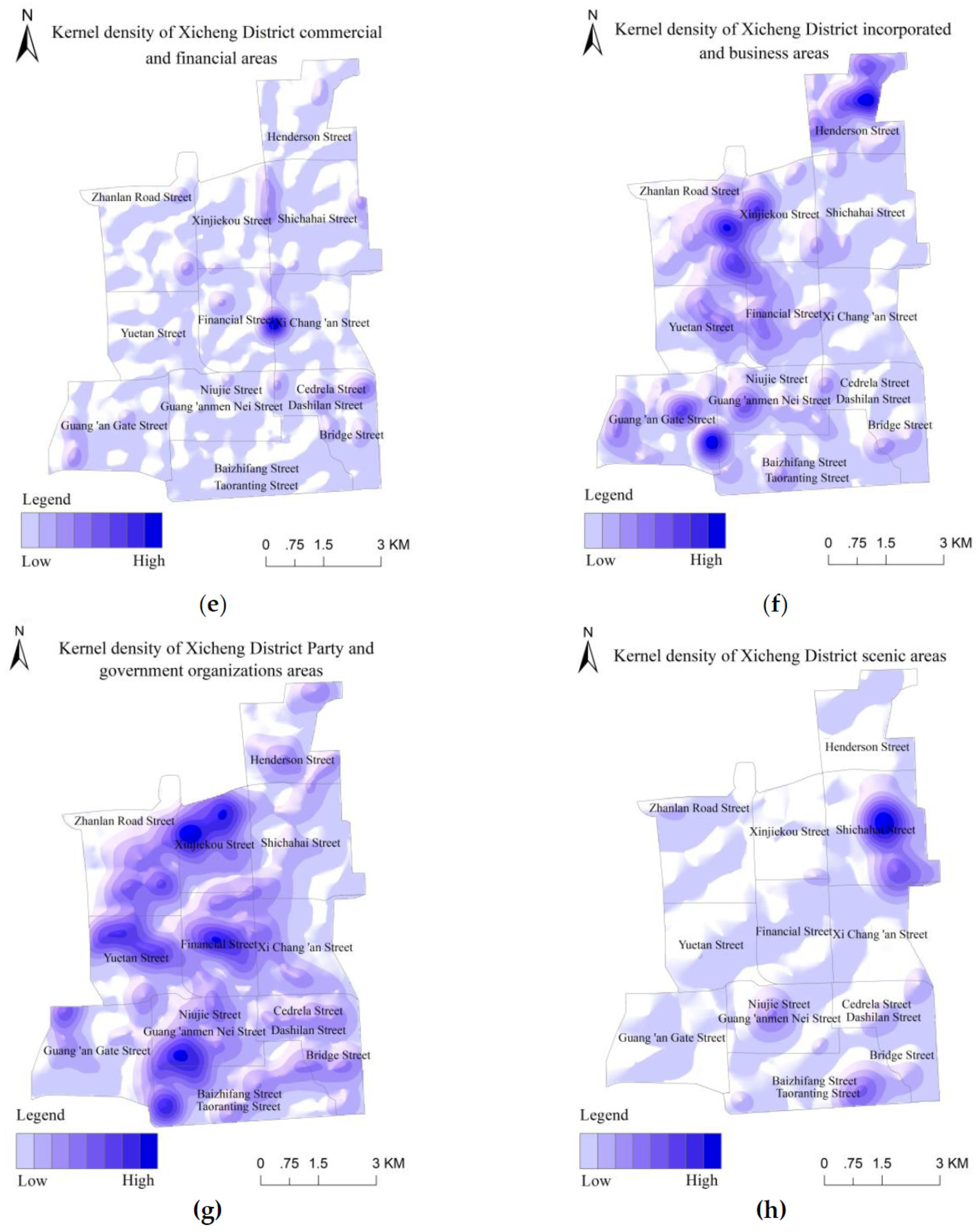
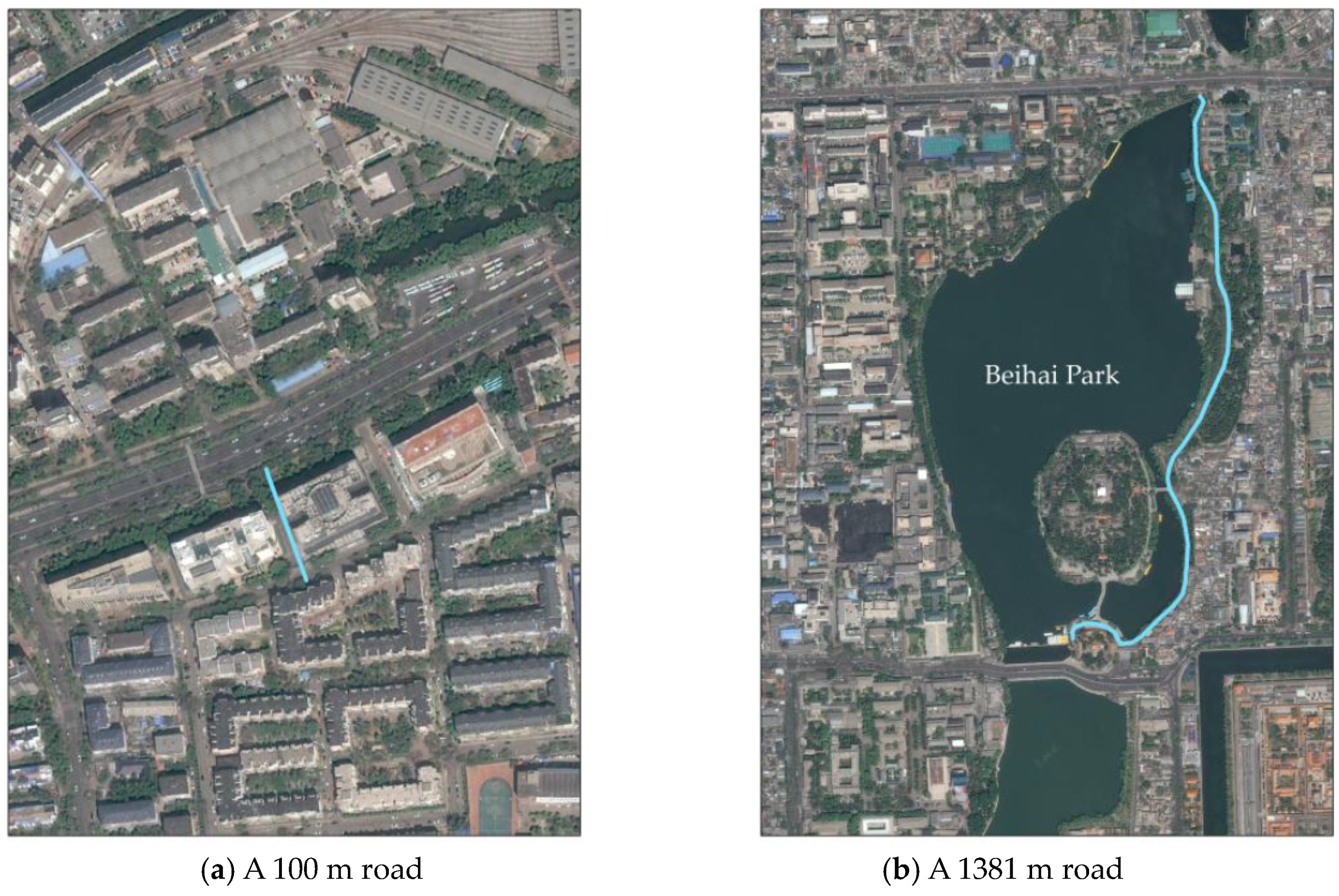

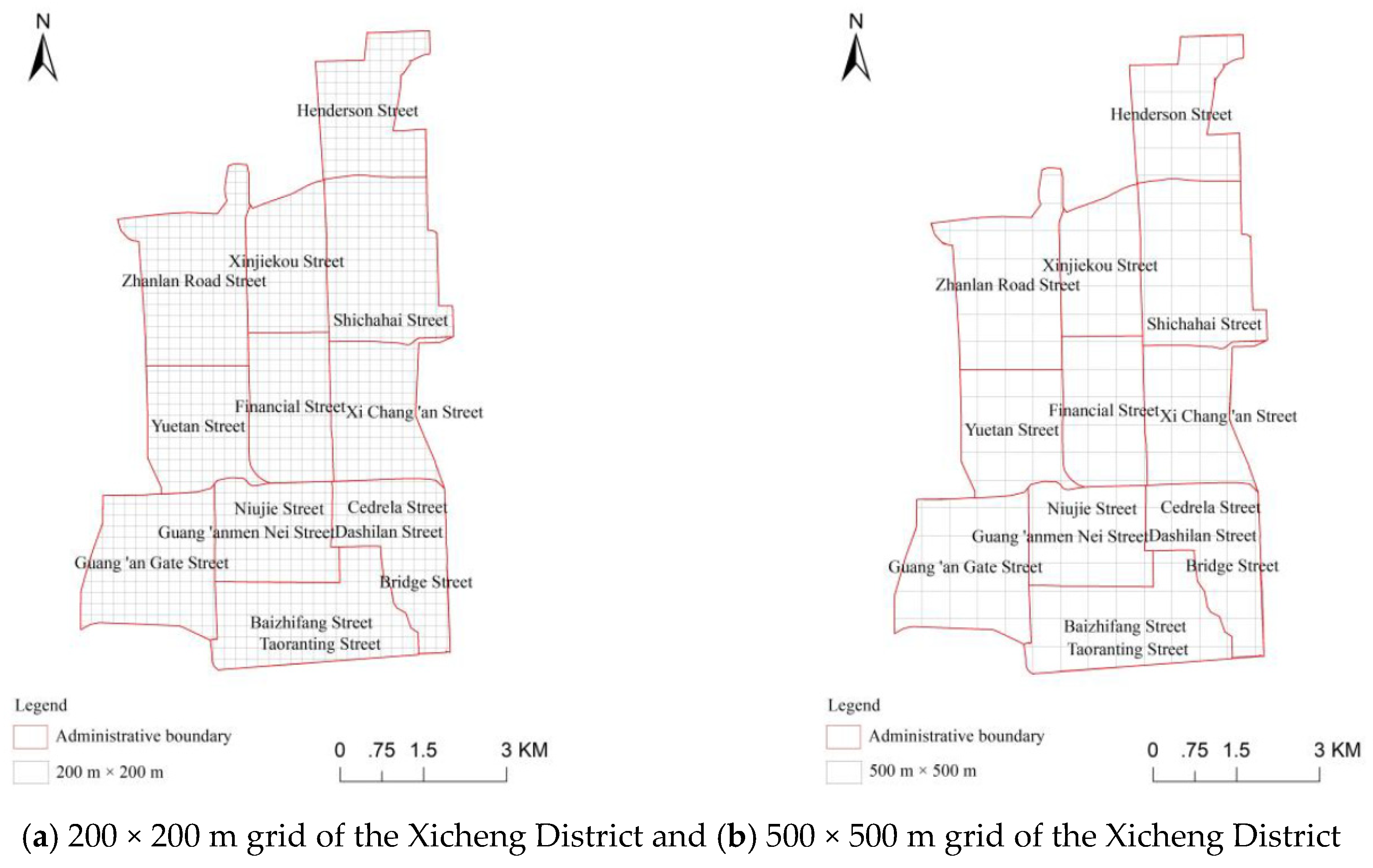
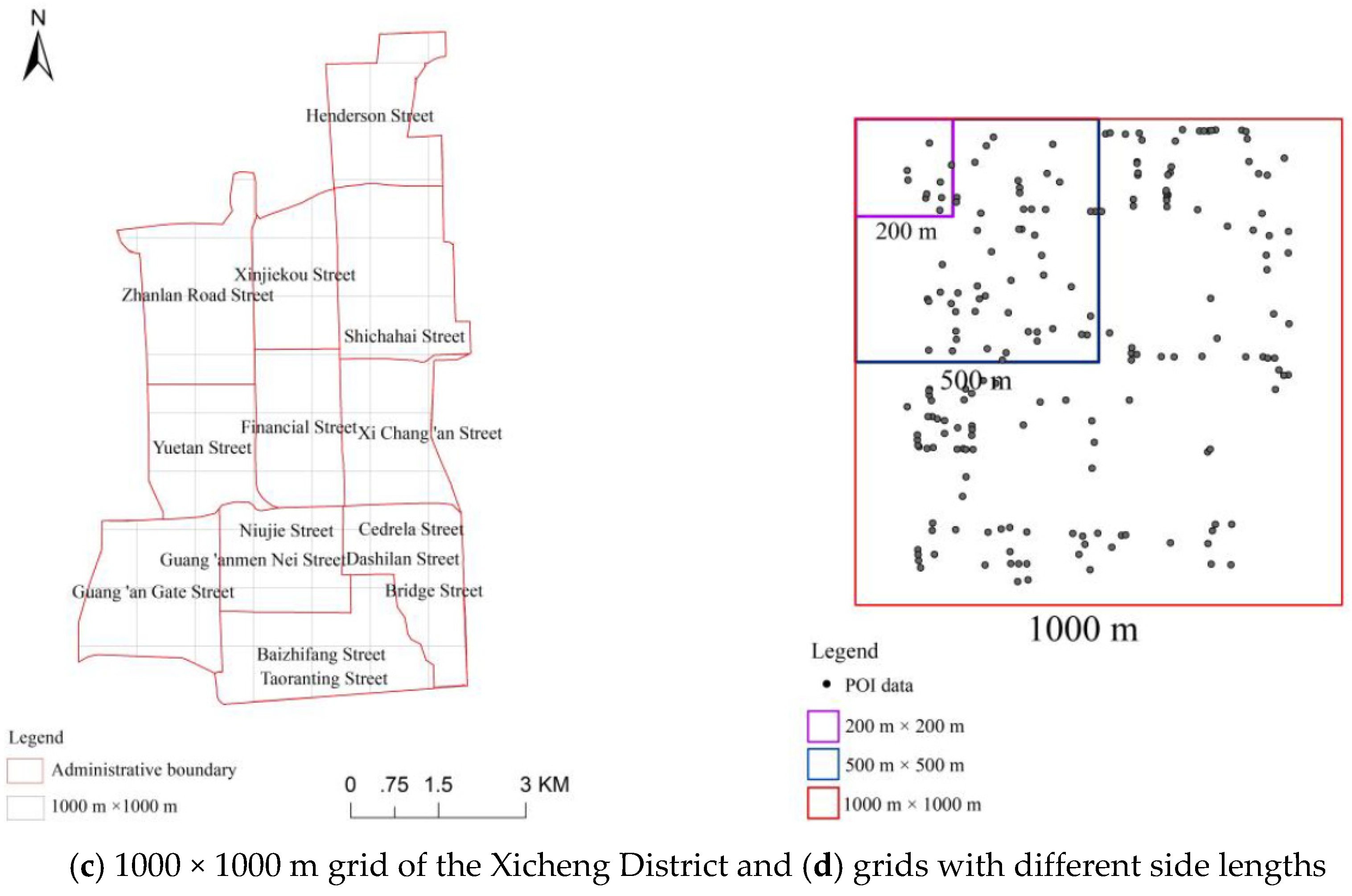
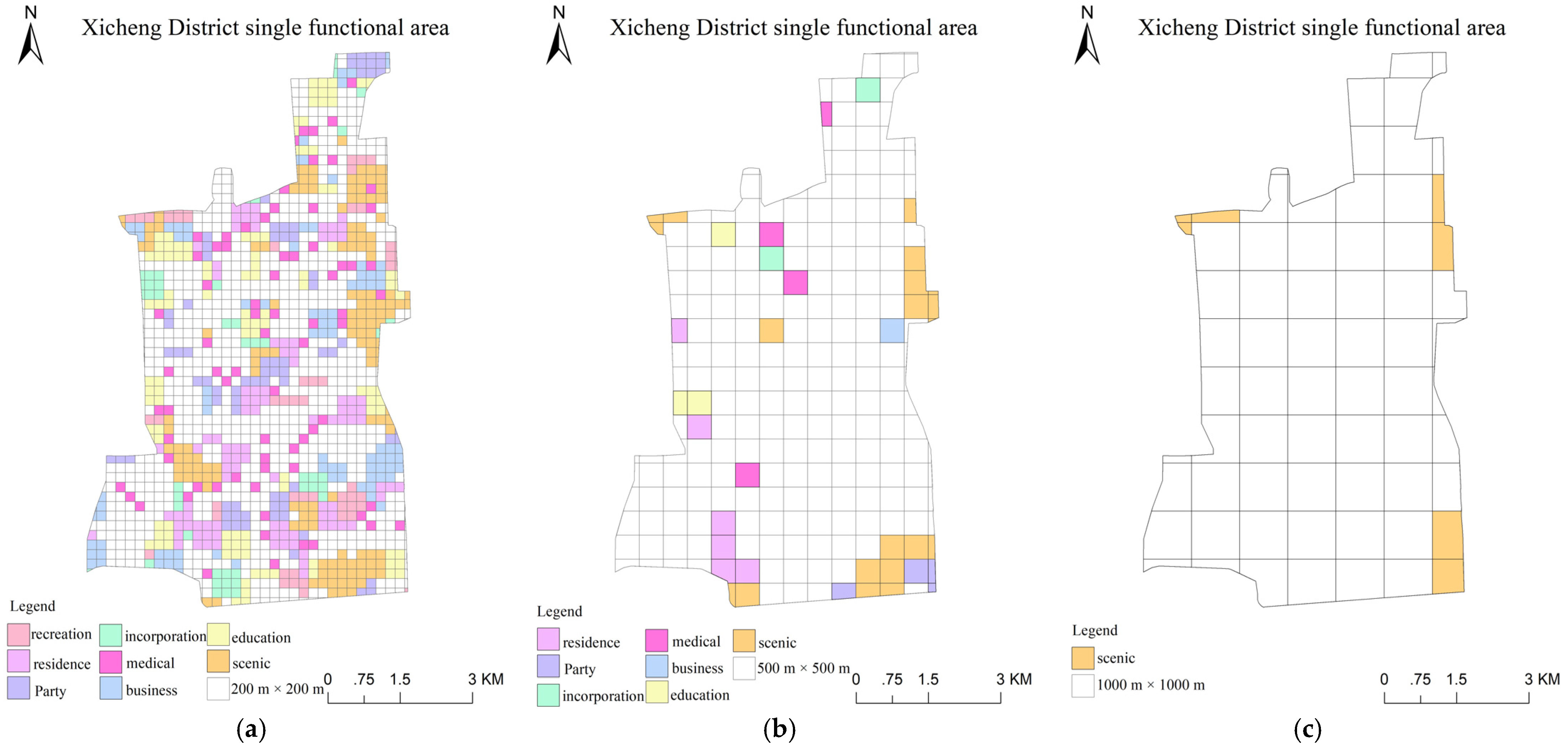
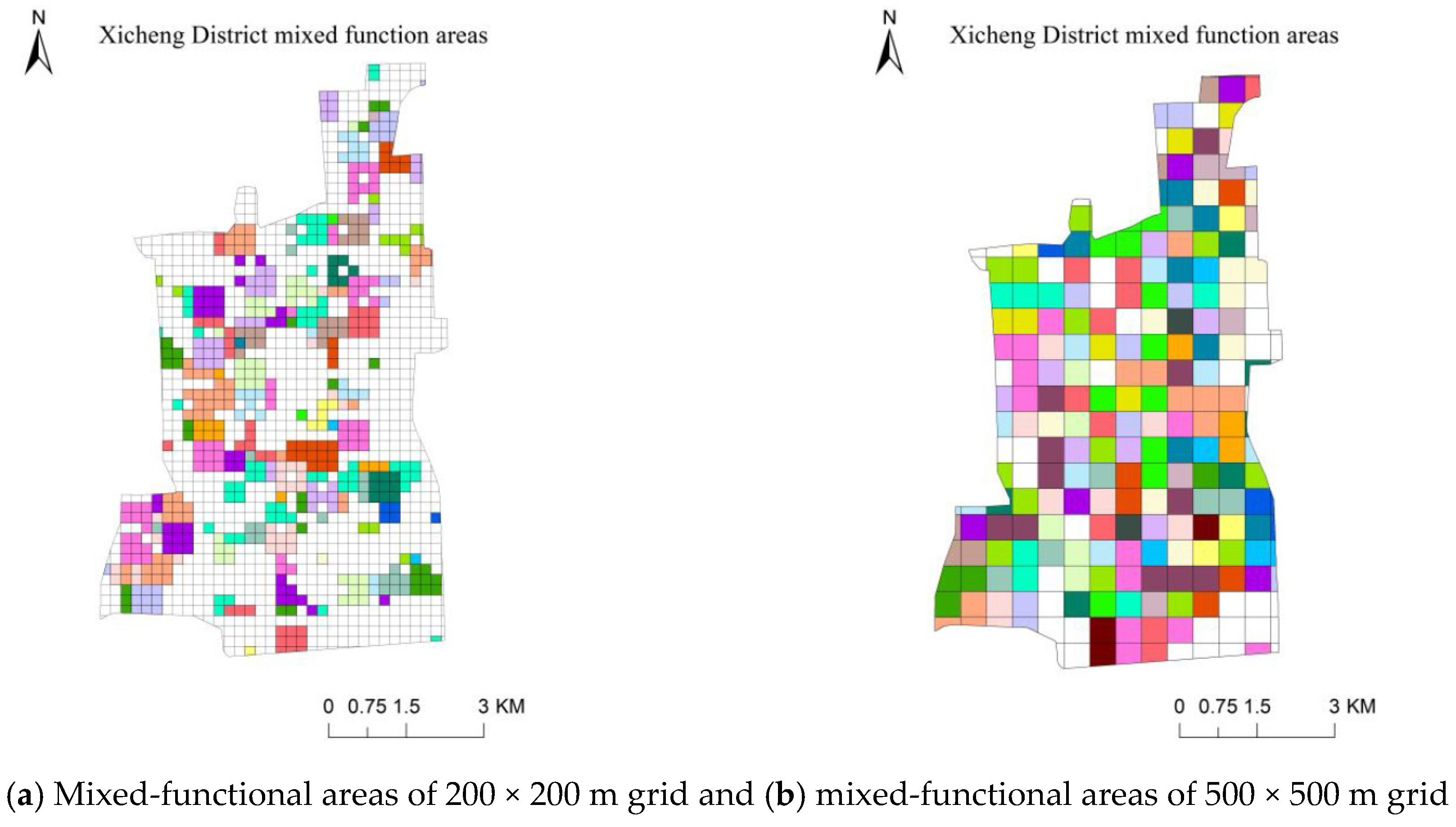
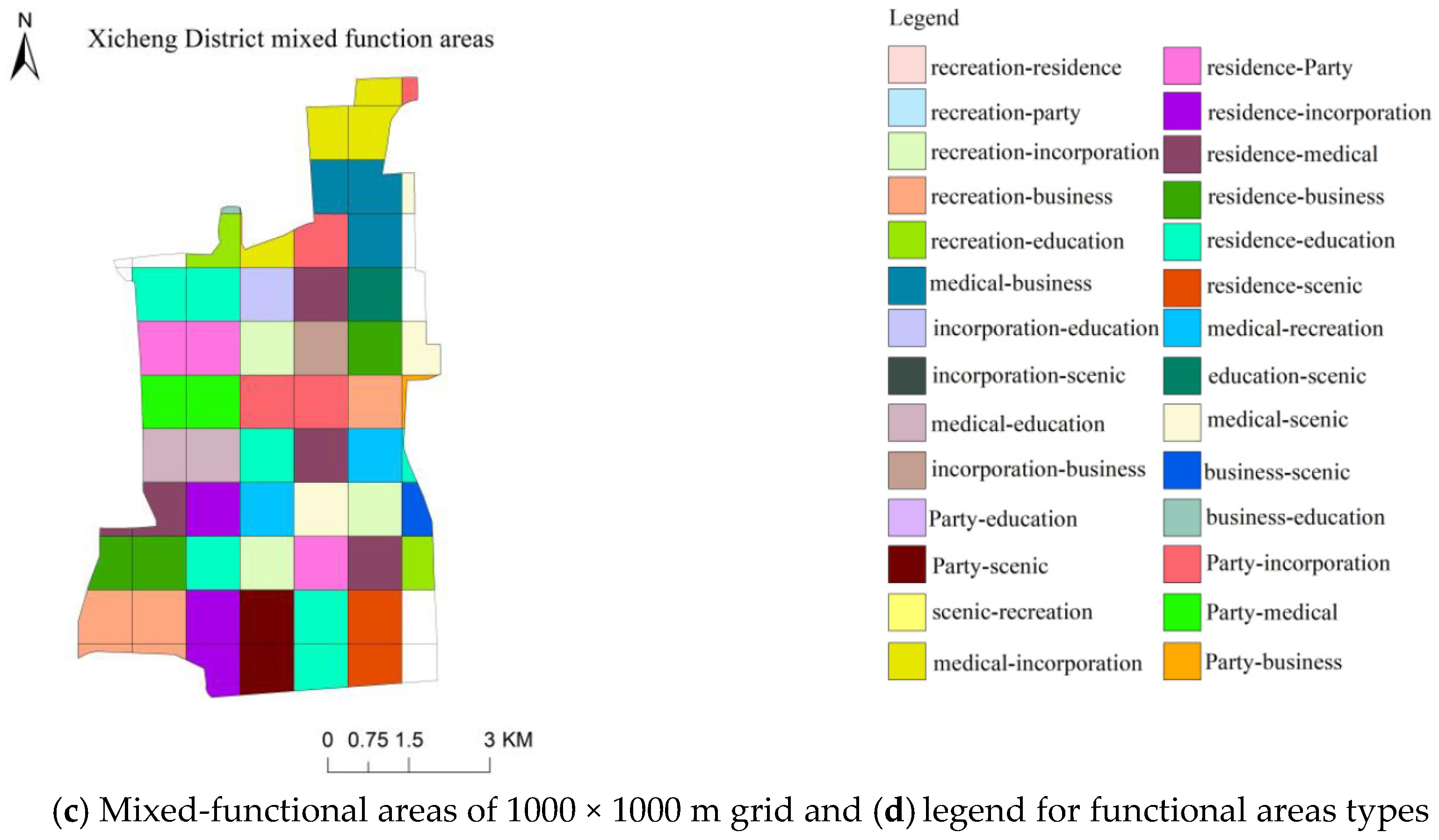
| Current Categories (Level One) | Current Categories (Level Two) | Current Categories (Level Three) |
|---|---|---|
| Residence | Water, electricity, gas service, life services, ticket office | Electricity repair, household management service, community service |
| Education and training | Low and middle education, continuing education, higher education | Primary school, high school, skill-training institution, university |
| Recreation and entertainment | Culture, recreation, sports and fitness | Museum, library cinema, amusement park swimming pool, gym |
| Medical and public health | Medical institutions, rehabilitation care, animal hospital | Hospital, clinic, convalescent hospital, animal hospital |
| Commercial and financial | Finance, shopping center, hotel | Bank, security, supermarket, catering, hotel, lodging |
| Incorporated business | Company, enterprise | Company, enterprise |
| Party and government organization | Government, administration | Public security, the People’s courts |
| Scenic | Scenic area | Tourist attractions |
| Recreation | Residence | Party | Incorporated | Medical | Business | Education | Scenic | |
|---|---|---|---|---|---|---|---|---|
| (a) Functional areas in the 200 m × 200 m grid | ||||||||
| Recreation | 53 | 21 | 13 | 14 | 1 | 46 | 6 | 1 |
| Residence | 7 | 98 | 36 | 25 | 0 | 26 | 36 | 10 |
| Party | 7 | 22 | 75 | 18 | 0 | 7 | 7 | 0 |
| Incorporated | 22 | 13 | 19 | 46 | 0 | 15 | 11 | 0 |
| Medical | 1 | 0 | 1 | 0 | 74 | 1 | 1 | 1 |
| Business | 12 | 6 | 4 | 0 | 0 | 88 | 14 | 5 |
| Education | 7 | 21 | 12 | 11 | 0 | 5 | 110 | 0 |
| Scenic | 5 | 14 | 0 | 0 | 0 | 0 | 15 | 152 |
| (b) Functional areas in the 500 × 500 m grid | ||||||||
| Recreation | 0 | 4 | 4 | 3 | 0 | 2 | 5 | 0 |
| Residence | 5 | 6 | 6 | 3 | 1 | 3 | 2 | 1 |
| Party | 5 | 6 | 4 | 1 | 3 | 1 | 3 | 2 |
| Incorporated | 2 | 2 | 10 | 2 | 2 | 5 | 2 | 2 |
| Medical | 5 | 10 | 8 | 4 | 4 | 8 | 5 | 8 |
| Business | 8 | 1 | 2 | 0 | 0 | 1 | 4 | 2 |
| Education | 9 | 4 | 4 | 8 | 1 | 2 | 3 | 1 |
| Scenic | 4 | 4 | 7 | 2 | 2 | 2 | 5 | 20 |
| (c) Functional areas in the 1000 × 1000 m grid | ||||||||
| Recreation | 0 | 1 | 0 | 0 | 0 | 4 | 1 | 0 |
| Residence | 0 | 0 | 0 | 2 | 0 | 1 | 4 | 0 |
| Party | 0 | 3 | 0 | 3 | 0 | 0 | 0 | 2 |
| Incorporated | 1 | 1 | 1 | 0 | 1 | 1 | 1 | 0 |
| Medical | 2 | 5 | 2 | 3 | 0 | 3 | 2 | 0 |
| Business | 1 | 2 | 1 | 0 | 0 | 0 | 0 | 1 |
| Education | 1 | 3 | 0 | 0 | 0 | 2 | 0 | 1 |
| Scenic | 0 | 2 | 0 | 0 | 3 | 0 | 0 | 7 |
| Grids | 200 × 200 m | 500 × 500 m | 1000 × 1000 m |
|---|---|---|---|
| Total number of quadrats | 1361 | 243 | 69 |
| Number of single-functional areas | 696 | 40 | 7 |
| Number of mixed-functional areas | 550 | 200 | 62 |
| Number of no-data areas | 115 | 3 | 0 |
| 51.14% | 16.46% | 10.14% | |
| 40.41% | 82.30% | 89.86% | |
| 8.45% | 1.65% | 0% |
Publisher’s Note: MDPI stays neutral with regard to jurisdictional claims in published maps and institutional affiliations. |
© 2021 by the authors. Licensee MDPI, Basel, Switzerland. This article is an open access article distributed under the terms and conditions of the Creative Commons Attribution (CC BY) license (http://creativecommons.org/licenses/by/4.0/).
Share and Cite
Luo, S.; Liu, Y.; Du, M.; Gao, S.; Wang, P.; Liu, X. The Influence of Spatial Grid Division on the Layout Analysis of Urban Functional Areas. ISPRS Int. J. Geo-Inf. 2021, 10, 189. https://0-doi-org.brum.beds.ac.uk/10.3390/ijgi10030189
Luo S, Liu Y, Du M, Gao S, Wang P, Liu X. The Influence of Spatial Grid Division on the Layout Analysis of Urban Functional Areas. ISPRS International Journal of Geo-Information. 2021; 10(3):189. https://0-doi-org.brum.beds.ac.uk/10.3390/ijgi10030189
Chicago/Turabian StyleLuo, Shaohua, Yang Liu, Mingyi Du, Siyan Gao, Pengfei Wang, and Xiaoyu Liu. 2021. "The Influence of Spatial Grid Division on the Layout Analysis of Urban Functional Areas" ISPRS International Journal of Geo-Information 10, no. 3: 189. https://0-doi-org.brum.beds.ac.uk/10.3390/ijgi10030189





